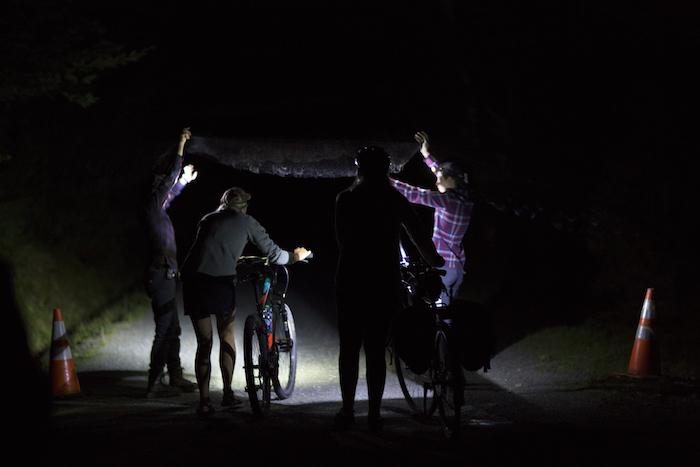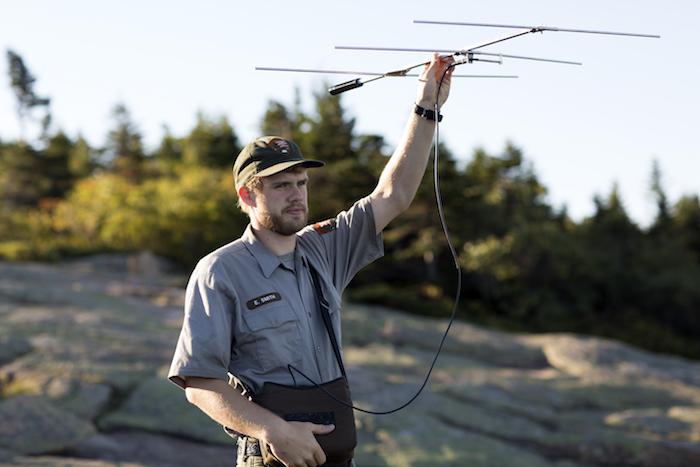
Volunteers help with a mist net setup to capture bats for research purposes on a carriage road in Acadia National Park/FOA, Julia Walker Thomas
Editor's note: The following story by Earl Brechlin, communications director for Friends of Acadia, appeared in FOA's summer journal.
The visiting public and long-term volunteers have a unique opportunity this year to assist Acadia National Park researchers this summer as part of the newly-created “Bat Watch,” program.
Since 2011, when researchers confirmed bats on Mount Desert Island were dying the deadly fungus known as “White-nose syndrome,” the number of bats seen in regular counts has plunged by 97 percent, according to park biological technician Chris Heilakka.
“Unfortunately, we’ve seen a dramatic decline. The Northern long-eared bat used to be the most common around here,” he explains. “Last year we only recorded two. The year before that we only saw one.”
White-nose syndrome was first identified in New York in 2006. Since then it has killed millions of bats in the northeast.

Biologist Erickson Smith uses a directional radio setup to track bats in Acadia National Park/FOA, Julia Walker Thomas
The three bat species mostly commonly seen in Acadia include the Northern long-eared, Little brown, and Eastern small-footed bats. All are listed as either threatened or endangered on the state or federal endangered species lists.
Some species prefer to roost in trees, others in rock openings or caves, while others prefer buildings. Getting to known locations to confirm bats still remain, and scoping out new locales, requires a lot of people power. And that’s where the idea of Bat Watch was formed.
The program meets every Thursday evening at park headquarters on Eagle Lake Road in Bar Harbor. Researchers share an educational slide show, and then review techniques for doing what are known as “emergence counts.” Groups then fan out into the field to look for bats.
In addition to a general assessment of the park’s bat populations, emergence counts help park officials plan maintenance projects, so they can be scheduled for times when bats are not raising their young. The peak bat maternity period is June and July. Females give birth to just one “pup.”
Recent rehabilitation work on the Paradis Hill Road bridge, for instance, was timed to avoid disturbing bats found to be roosting there during “pupping” season.
“We do counts in areas we know there are bats and for the compliance work as well,” Heilakka says.
Volunteers who wish to make a longer term or even season-long commitment, can get advanced training.
In addition to watching likely locations for the emergence of bats at dusk, or observing feeding behavior, other survey techniques include acoustic monitoring, and the use of mist nets to capture bats so they can be measured, banded, and in some cases, fitted with tiny telemetry devices so their habits and behaviors can be monitored electronically.
Providing there is no more than a 40 percent chance of rain, Bat Watch operates on Thursday evenings through fall. The times are: July: 7 to 9:30 p.m., August: 6:15 to 9 p.m., September: 5:30 to 8 p.m. Advance registration is required. Email: [email protected]. Please include “Bat Watch” in the subject line.
For more information contact Chris Heilakka at 288-8840.

A northern long eared bat/NPS
Bat Myths
The old expression “blind as a bat,” couldn’t be further from the truth. They operate quite well in dark environments. The night vision of some species is three times better than humans. They do use echolocation (sound waves) to help navigate.
Bats as pests
Humans actually derive numerous benefits from bats. A single bat can eat thousands of insects in a single evening. The economic benefit of that globally is put at $53 billion. Bats help pollinate plants, spread seeds, and droppings, known as guano, make excellent fertilizer.
Bats are not mice
Although bats are the only flying mammal, they are not rodents. They are more closely related to chimps. They do not damage structures by chewing on wood, metal or wires like mice and rats.
Bats and Vampires
Only three of the world’s 1,200 species of bats consume blood – none in the United States or Canada. Small bats in South America are called “Vampire Bats. They lick blood from wounds on cattle, not drink it as is often portrayed in works of fiction.
Bats and hair
Bats don’t want to get tangled in people’s hair or make a nest. In fact, they don’t nest at all. The reason they sometimes swoop near people’s heads is to capture insects that swarm there.
Bats and rabies
Scientists say bats have lower rates of rabies infections that other mammals such as raccoons and foxes. While those species may display aggressive behavior if sick, bats usually just become paralyzed. Avoiding bats on the ground reduces the risk to almost zero. – Earl Brechlin



Add comment